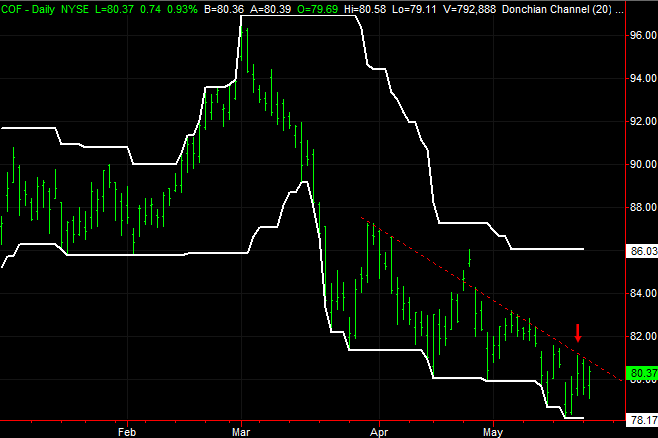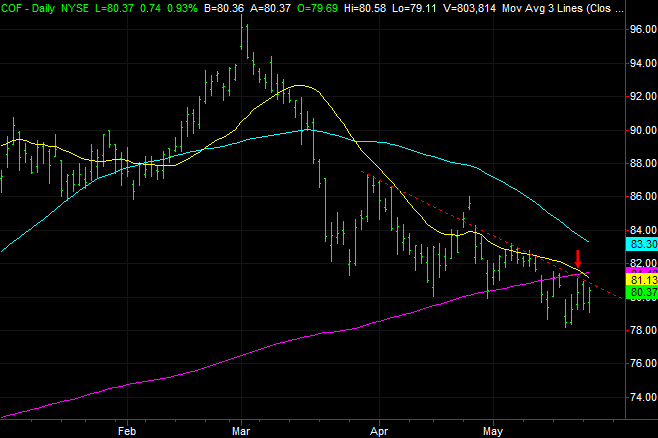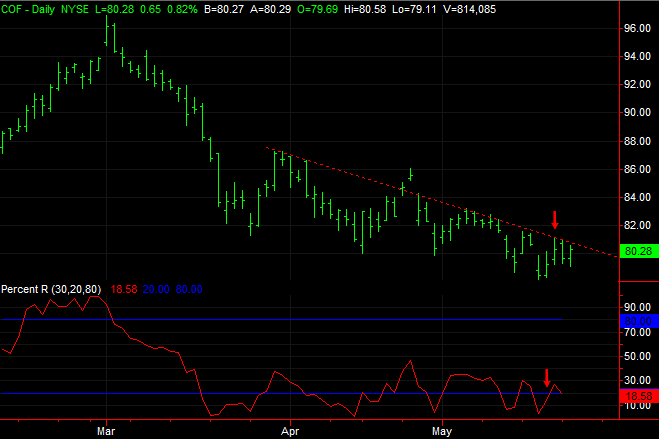Capital One Financial (COF) Points to the Power of Slow-and-Steady Donchian Lines

On Friday of last week, our Afternoon Channel Trader alert service recommended a bearish trade on Capital One Financial (COF). Specifically, the newsletter suggested the Capital One (COF) June monthly 87.5 puts (COF 170616P87.5), which expire on June 16th.
Normally we don't divulge trades until they're entirely closed out. But, in light of the fact that we've already locked in a profit on half of the original position and we're close to an exit on the remaining half -- and given that there's so much to learn from this trade-setup -- we're going to go ahead and explore the nuances of what we saw on the chart that prompted us to pull the trigger. Spoiler alert: Though we focus on one indicator for our Afternoon Channel Trader, Capital One Financial had several things going for it at the time.
First and foremost, know that the Afternoon Channel Trader alert service is primarily driven by Donchian channels... a technical indicator that's ideally suited to capitalize on the very small swings from a stock or index that most traders prefer to ignore because they seem too small to bother trading. Though the scope of the moves the Donchian channel lines can point to are indeed minor, it's a reliable tool. Those nickels and dimes can really add up while everybody else is swinging for the fences (and often whiffing altogether as a result).
Let's let the chart of COF with its Donchian channels speak for itself. Just note that the channel settings we've applied on our chart here aren't the exact same ones we use for our service; we have to protect some of our best proprietary information.
It's pretty easy to see that back on the 19th when we entered the bearish/put trade that Capital One was trapped below a falling resistance line. It wasn't just the fact that COF was under pressure at the time from a falling resistance/ceiling though... a channel of a different sort that was guiding COF downward. At the same time, Capital One Financial shares had also recently fallen below its 200-day moving average line (pink) -- the last of the potential support levels -- and the 20-day moving average line was en route to do the same. That was confirmation that the downtrend had turned bearish in all key timeframes. Given the situation, we had good reason to believe that 20-day moving average line (yellow) would become technical resistance as well.
Last but not least, the day before we entered into COF June monthly 87.5 puts we had just gotten a confirmed PercentR sell signal. That is, Capital One shares hit a new low (actually that low was hit the day before, but it worked out all the same in this case) after the PercentR line was below the 20 threshold. Like the multiple moving average lines, this serves as confirmation that the selling trend has taken hold in a big way.
The irony is, while the Donchian channel indicator was arguably the weakest bearish clue we had at the time [bearing in mind again that the chart you see above isn’t based on the same setting we normally use; ours looked notably different], it was still a good signal mostly because we had two other very strong clues saying the same thing. Indeed, with COF we got into a bearish position specifically because it had pushed up and off the lower Donchian line but we had no real reason to expect that bounce to go anywhere. In other words, we got into the downtrend on a short-term bounce. In a different scenario, we may have interpreted the action around the Donchian lines differently.
The moral of the story in this particular case was and is, it never hurts to get a second and even a third opinion.
From a bigger picture point of view, the chart of COF with its Donchian channels above illustrates the power of the rarely-used tool. Sometimes a reliable single is better than an unreliable home run.
Though it doesn't always serve as a ceiling or a floor -- as you can clearly see in February and March -- when it is working as a floor or ceiling, it does so with great precision, spotting the very small two to four/five day swings most everyone else ignores because they’re not deemed big enough. You can see in January and early February how all it took was a kiss of the lower Donchian line to start a couple of tradeworthy moves. The lower Donchian channel line also sparked some tradeworthy bounces in April as well as this month.
None of them were monster-sized winners, mind you, but again, we don’t need them to be. There’s nothing wrong with booking 20% and 30% gains on a pretty consistent weekly basis, which is where this tool really shines. We’ve already booked a 21% gain on the Capital One Financial put trade, and we’re holding the second half looking for a little more gain…. something we can comfortably do because we already have a profit cushion from the first half of the position.
For more on Donchian channels and the Afternoon Channel Trader alert service, go here.


